What Does it Mean to be Consistent?
From a call center perspective, consistency means that customers always experience great service when they contact and interact with any agent they talk to, chat or email to resolve their inquiry or problem. However, call centers provide great or poor customer service consistently or are inconsistent in their service delivery.
An example of great customer experience (CX) delivered consistently is when they use your call center; it is always easy to reach someone, and the agents are always friendly, caring, and helpful, and they always resolve the customer inquiry or problem on the first call. It is easy to state what good CX consistency should be but challenging to achieve.
SQM's CX research shows that 93% of customers expect their interaction to be resolved on the first call using the call center touchpoint, and 72% expect the interaction to be resolved on the first contact using the web touchpoint.
Given the high percentage of customers who expect their interaction to be resolved on the first contact, it is a high indication that customers expect consistent contact resolution experiences for all touchpoints. Therefore, First Contact Resolution (FCR) is an excellent metric for determining call center is delivering great CX consistency. For example, for every 1% improvement in FCR, there is a 1% improvement in customer satisfaction.
Furthermore, when call centers achieve 80% or greater FCR consistency, SQM Group's research shows it positively impacts customer loyalty. For example, 95% of customers expressed intent to continue doing business with a company when FCR is achieved. Therefore, the more consistent a call center achieves 80% or greater FCR, the higher the positive impact of helping the company deliver great customer satisfaction and increase customer loyalty.
Consistency is the Key to Great Call Center CX Delivery
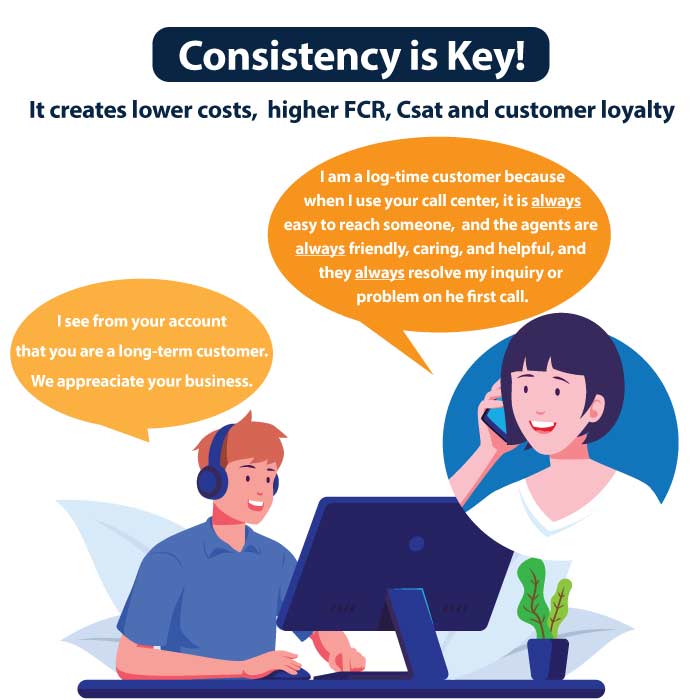
Customer Satisfaction Measurement
Today's connected customers expect to resolve their inquiry problem on the first touchpoint regardless of what touchpoint they choose to use. As a result, most companies say they are trying to deliver consistent CX using touchpoints to resolve an inquiry or problem.
However, most companies don't consistently measure customer satisfaction (Csat) using touchpoints (e.g., IVR self-service, mobile self-service, email, and chat). Although, call center and web self-service channels Csat tend to be measured more frequently than other touchpoints.
Also, for customers using multiple touchpoints to resolve the same inquiry or problem, Csat is seldom measured. Therefore, it is tough to improve when you don't measure CX using a touchpoint or when two or more touchpoints are used to resolve the same inquiry or problem.
Moreover, SQM Group's research data reveals that when customers use only one touchpoint (e.g., call center, website, IVR, chat, or email) to resolve their inquiry or problem, the average Csat top box response is 73%. However, Csat drops 19% for each additional touchpoint used to resolve the same inquiry or problem.
SQM's touchpoint CX research data revealed that 40% of customers used two or more touchpoints to resolve the same inquiry or problem. For example, a customer used the web touchpoint while at the same time talking to a call center agent.
At SQM, we define an omnichannel as when a customer experience is seamless across all touchpoints to resolve the same inquiry or problem. Put differently, when a customer used another touchpoint to resolve the same inquiry or problem, they could pick up from where they left off at the previous touchpoint and, as a result, did not have to start from the beginning. Conversely, in a non-seamless experience, customers had to begin their interaction from the beginning each time they used another touchpoint to resolve the same inquiry or problem.
SQM Group's research shows when a customer has a seamless experience resolving the same inquiry or problem, Csat (e.g., top box survey response) is 67%. However, for customers who did not have a seamless experience in resolving the same inquiry or problem, Csat is an alarming 28%.
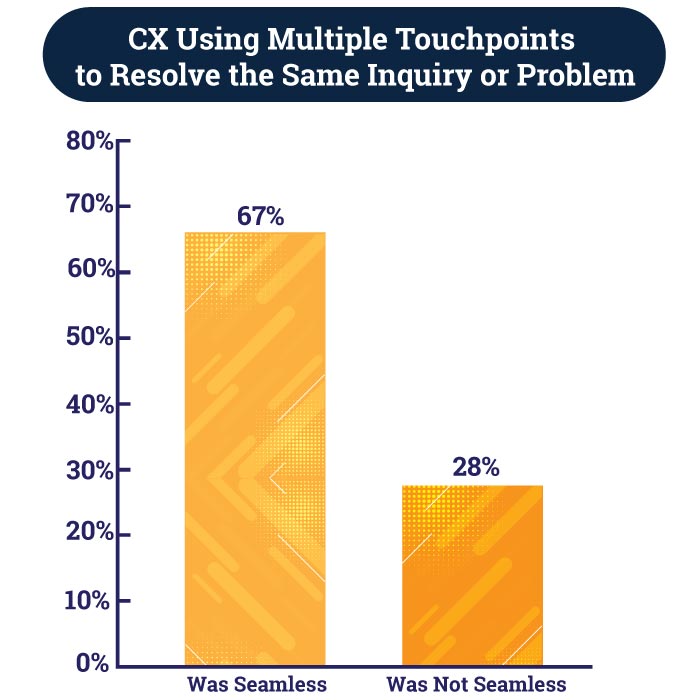
4 Best Practices for Delivering Great CX Consistency
1. Voice of the Customer
It is a best practice to let the customer determine if your call center delivers consistent great customer service by conducting post-call surveys within one day of their interaction. Voice of Customer (VoC) is a term that describes a customer's feedback to understand their expectations and experiences doing business with a call center and to identify customer service inconsistency opportunities to improve.
The VoC practice lets the customer be the judge of their experiences. VoC uses listening posts (e.g., phone surveys, email surveys, call monitoring, CRM, social media, and employees) to understand customer needs, wants, expectations, moments of truth (MoT) experiences, and inconsistency improvement opportunities.
For example, the below figure shows the essential MoT customer experiences when calling a call center. These call handling moments of truth apply to all call centers and industries. The call center MoT is derived from common sequential experiences a customer has when calling a call center. MoT does not include back-end operational aspects such as claim fulfillment or service work departments.
Call Center Customer Service MoT includes:
- finding the phone number
- reaching the right agent
- a warm greeting from the agent
- the agent understanding the reason for the call
- the agent helping the customer
- agent caring about the customer situation
- agent resolving the call
- after-call work if necessary
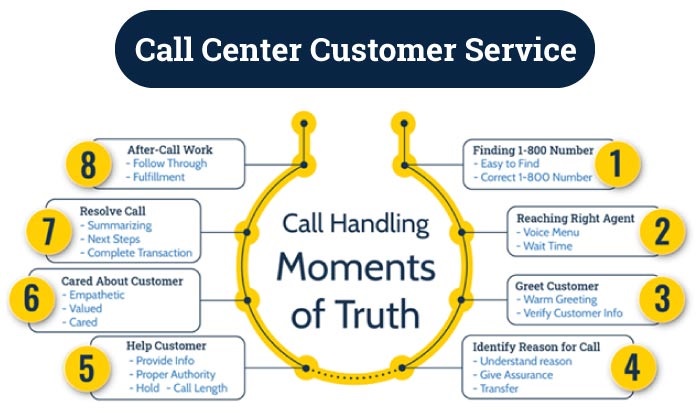
Once you have determined overall FCR and Csat performance, you can assess moments of truth (MoT) experiences and inconsistency improvement opportunities. It would help if you then analyzed the following root causes:
- Are there organizational policies and procedures that hinder the FCR/Csat?
- Are there customer issues or confusion that hinder FCR/Csat?
- Do agent desktop applications or lack of resources hinder FCR/Csat?
- Do agents have the skills, knowledge, and abilities to resolve calls?
- Do agents have the necessary coaching to resolve calls?
- Do agents have the motivation and recognition to resolve calls?
- Do your agent call handling (e.g., talk time, wrap up, transfers, hold, etc.) practices hinder FCR/Csat?
- Are the agents accountable for call resolution and Csat?
2. Customer Quality Assurance
What is Customer Quality Assurance (CQA)? CQA is a holistic view of quality assurance that represents both the customer and the company's perspective by combining customer surveys and call compliance metrics. CQA is widely considered a best practice for consistently standardizing CX expectations that agents need to deliver.
CQA uses VoC data to judge call quality to enhance, not replace, the established call monitoring process. The customer survey information alone cannot replace the entire QA process because there are some call center metrics that the customer cannot judge (e.g., compliance and information accuracy). Thus, it is still necessary for the call center monitoring team to evaluate these metrics or use analytical tools to determine call compliance.
The most effective CQA program for the call center is a two-part process that blends external VoC evaluation with internal call evaluations. First, each agent receives a CQA evaluation report consisting of the customer survey and the call compliance results for the same call.
Evaluation Scoring Breakdown
As shown by the below figure, the CQA evaluation scoring is a total of 100 points, comprised of:
- 60 points are available based on customer survey results, and 40 points are available based on call compliance metrics.
- Of the 60 points allocated for customer survey results, 40 points for call resolution, and 20 for customer satisfaction.
- Of the 40 points allocated for call compliance metrics, 30 are customer-focused, and 10 are organization-focused.
- CQA point allocation is 90% skewed towards customer metrics (i.e., 60 points from the customer survey metrics and 30 points from call compliance metrics).
- Having 90% of the CQA evaluation form allocated towards the customer's experience sends the message to agents that the customer's experience (e.g., call resolution, Csat) is what matters in the CQA evaluation program and to the organization.
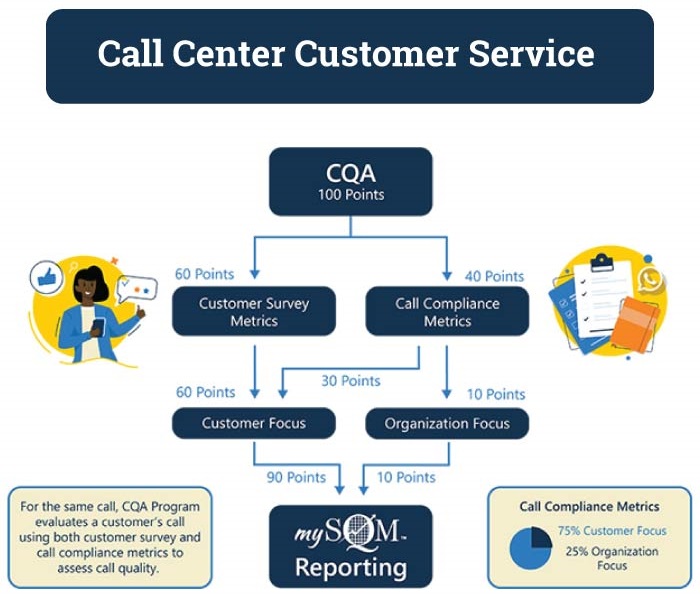
3. Standard Operating Procedures
A standard operating procedure (SOP) is a set of step-by-step instructions compiled by the call center decision makers to help employees (e.g., agents, supervisors) consistently deliver CX to the organization's standards. SOPs aim to achieve efficiency, quality output, and performance consistently while reducing miscommunication and failure to comply with industry regulations.
Many call centers use SOPs to help deliver FCR and provide great Csat. Usually, call center SOP practices are specific to their operation and describe the activities needed to complete a task according to an organization's standards for handling specific inquiries and problems.
It has been SQM's experience that most call centers have used SOP practices to varying degrees for a long time. However, call centers performing at high FCR and Csat levels tend to be effective at SOP call handling practices for all their core call types and lines of business. In addition, SQM has many clients who have improved their FCR and Csat performance by improving their existing SOP practices and consistently applying them.
Call center of the year and SOP best practices award-winning Genworth call center uses the documentation below to update and consistently apply SOPs.
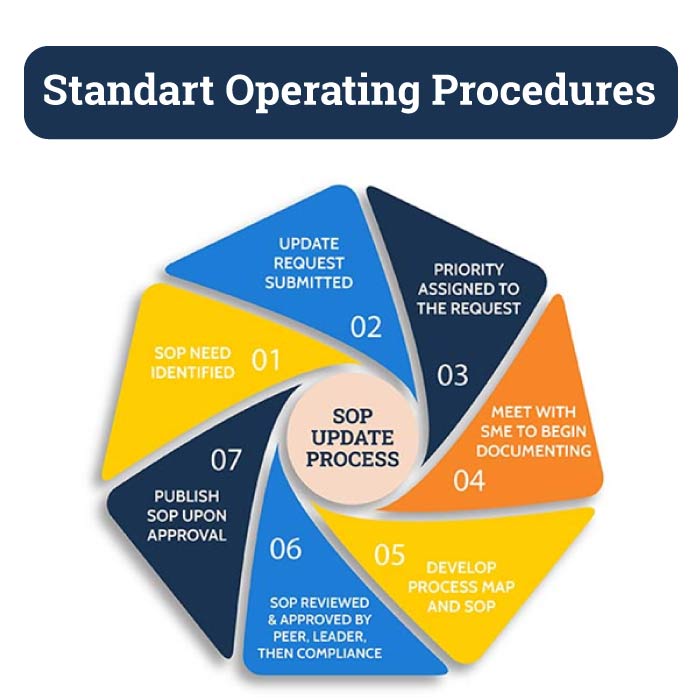
4. Call Handling Practices
Call handling is about managing inbound and outbound phone calls that a call center receives and makes. For example, it allows a call center to route incoming calls to the right agent with the necessary call handling skills to resolve the customer's inquiry or problem effectively and efficiently.
Call handling is one of the best opportunities for consistently delivering First Call Resolution and Customer Satisfaction. Unfortunately, SQM's research shows that the agents were the source of error is approximately 40% of non-FCR calls.
Call handling encompasses business practices such as intelligent skill-based routing, first call resolution focus, how calls are handled, concierge service, complaint handling, and agent and customer communication styles.
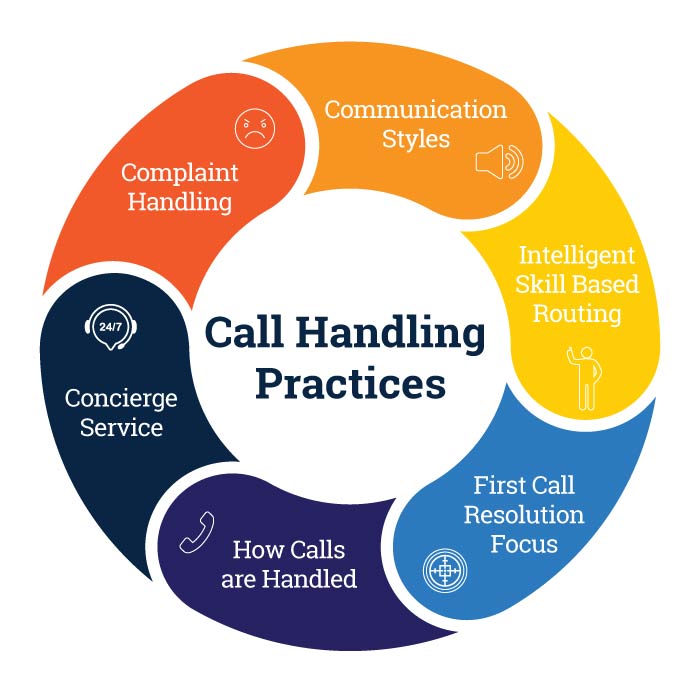
Intelligent skill-based routing is a call assignment practice used in call centers to consistently assign incoming calls to the most suitable agent rather than simply the next available agent.
Call centers must consistently focus on First Call Resolution performance to deliver great customer service.
Resolving inquiries or problems and satisfying customers requires agents to be consistent with how they handle calls.
Consistent usage of concierge service is moving from the hospitality industry to the call center industry to enhance CX.
Enlighted call centers use consistent practices for identifying and handling customer complaints to ensure service recovery takes place.
The best CX performing agents consistently adapt and match their communication style to customer Persona Communication Styles.
Quick Related Links
First Call Resolution Comprehensive Guide Customer Satisfaction Comprehensive Guide Top 10 Call Center Metrics VoC Closed-Loop Outside-In or Inside-Out Journey Mapping Good to Great Customer Service CSM Software Software Business Case

